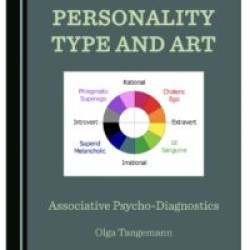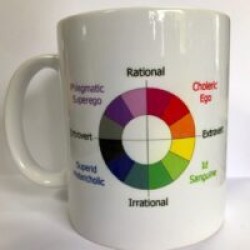A vulnerable channel of functions is associated with fears and with information that a person wants to only see positive. Negative information can slow you down and put you in a state of panic, where you begin to think and act inappropriately and can’t do anything about it. This behaviour can be repeated and manifested in the form of obsessive, disturbing thoughts, as well as inappropriate actions. For example, you may be overly cautious, focusing too much on details and investing too much effort in a relatively simple task or you imagine a problem where it does not exist and find it hard to correlate reality with probability.
A person is often frightened, not by the very fact of what is happening, but by the image that his imagination draws. It’s frustrating to hear from others about bad events related to functions in a vulnerable channel. At the same time, you can gratefully accept help, care and advice.
Sensing
1) If your vulnerable channel is of a sensing function, then negative information about your health and your physical appearance will be perceived by you sensitively. You may be overly sensitive to noise and sounds like someone chewing food at the table. Your fear and irritation may apply directly to you, to the loved ones or even to objects surrounding you. For example, there are tactless people who can make a comment about your lower status in the community, disadvantaged position at work, your health issues, the quality of the food you eat or the clothes you wear, your personal hygiene or cleanliness (dirty hands, nails, smell, bacteria, etc.)
Ethics
2) If your vulnerable channel is of an ethics function, then we are talking about the fear of being rejected and insulted, misunderstood by others, to be an outcast, condemned. This is the fear of being unethical, fear of negative opinions about your personality, as well as ridicule, humiliation, negative emotions, conflicts, etc.
Logics
3) If your vulnerable channel is of a logical function then this is the fear of being perceived inconsistent in judgement and actions, not being able to prioritize, not knowing facts and generally not being smart enough.
While a person with vulnerable logic may successfully engage in theory, they may tend to draw conclusions based on subjective assumptions and fantasy. To motivate yourself to do jobs around the house, organizing information and keeping things in order can be difficult.
Intuition
4) If your vulnerable channel is of an intuitive function, then a person is afraid of the negative development of events, fatal accidents and situations that are beyond their control. The person is afraid of failure, everything bad that can happen to him, his loved ones or personal property. Fear can appear before a choice is made or after a decision is made.
While in some situations vulnerable function can create trouble to a mental state of a person it is not always the case. It depends what other function it is paired with and how it is used. The negative attitude towards vulnerable function comes from the concept of quadras and the idea of valued and unvalued functions. From the point of 4 quadras – small groups of types with dual function values, the vulnerable function is unvalued. This is not that simple because the function is positioned in the mental part of model A which is considered to be a mental or conscious function.
We are aware of our needs and weaknesses related to this function. This means we cannot ignore how we feel in relation to this function. The choice of the name “vulnerable” is not accidental. The Superego block, where the function is located in the model, ensures that a person complies with the norms of the society. People feel usually compelled to use the functions of Superego block appropriately to avoid being judged.
Fear and irrational anxiety related to the vulnerable function may arise unprompted. Anxiety to fail in the eyes of others stems not only from a desire to be liked by others, but also to be on par with their level of ability. Without even knowing Socionics, a person feels a need to be not worse than others on Superego functions.
It’s a completely different matter with the functions of the Superid block, which are located in the weakest block of the Model A. The Superid block has always been associated in Socionics with the Collective Unconscious of Carl Jung’s psychological theory. This block of functions only becomes a concern in situations of sudden crisis. A person typically does not even have interest in developing these functions. The lack of interest applies to all the functions located in the vital part of model A, because these are understood to be less realised and less used than mental functions.
While people do not see the need to develop their weakest functions of Superid, they are glad to accept help when it’s most needed. The process of learning to use those functions is very difficult, and one is more prone to forget experience and information gained in this area. Nevertheless, in cases of necessity, frequent use, and determined effort, we can still improve upon these functions. Often than not, people refuse to change themselves and they may say something along the lines of: “Yes, I am like this; always have been, and always will be.”
A person needs to accept himself as he is: everyone has their faults. This is important to remember in building personal relationships. If your partner is not ready to accept inadequacies related to your weakest functions, and deal with your shortcomings in a very understanding and patient way, they will not be able to get along with you. For example, inappropriate behaviour resulting from the weakness of suggestive Fe is best tolerated by types with an ethical base function. Those types with extraverted ethics Fe as their leading function can skillfully manage the weaker Fe of their partner. Introverted ethical types can gracefully overlook the inappropriate manifestations of their partner’s suggestive Fe by using their own tolerant and loyal Fi.
It’s not uncommon that during type diagnostics we see subjects misjudging strengths and weaknesses related to their base and vulnerable functions. For example, people of Yesenin type, IEI, often see themselves as logicians because they think a lot. People of the Dreiser type, ESI, go the extra mile in searching for the best choice and may therefore perceive their intuition as relatively strong.
People are driven to work on their fears, to gain peace of mind and a sufficient degree of confidence. They want to believe that they have done everything possible to protect themselves, improve their position in society and succeed in their cause. Therefore, it is completely natural to hear from some people that they not only have an adequate grasp of their vulnerable aspect but are better than average. At the same time they feel amused at how carelessly others use their vulnerable function – something that in their eyes requires a careful approach.
What else is important to know about the vulnerable function? We often observe a rigid polarity in people’s reactions to their “vulnerable” function (VF): they either work very hard at using their VF in order to alleviate anxieties related to their deficiencies or … they choose to ignore it entirely. It depends on what other function it is paired with as well as whether the matter is of personal interest and an urgent need. If operating in tandem with one’s “base” or “creative” function, then its use comes easier, and maybe of particular interest to the individual. If operating with the “role”, or in conjunction with another weak function, VF would require more effort and generate more stress. Nevertheless, the more experience and knowledge one has gained in working with the functions of their Superego block, the more skilled and confident one will be with utilizing them.
In the Model A the “vulnerable” and “mobilizing” functions constitute what we call the vulnerable channel. Similarly, the other functions are also paired into channels based on the same Jung function and the dichotomy of introversion – extraversion:
The base channel includes “base” and “ignoring” functions; creative channel – “creative” and “demonstrative” functions; the role channel– “role” and “suggestive” functions.
Why did we connect the functions of different vertices (attitudes) into channels? To emphasize the interconnected and interdependent nature of these functions. They constitute one and the same Jung function. If a person has extraverted intuition in their “vulnerable” function, then they will have a similar attitude towards their “mobilizing” function of introverted intuition. Anxiety extends to both functions.
When using functions in creative and vulnerable channels, a person creates new information, because these functions are productive in Socionics theory. It is easier to use stronger functions in the creative channel. The product of these functions is confidently shared with others. Using the functions of their vulnerable channel, a person gains experience and knowledge, draws conclusions and produces information primarily for themselves without having a particular desire to share it with the world. But this does not mean that a person cannot create something new and unique to share. The sharing of new information produced through vulnerable functions is limited because a person may feel less confident about it. We also know the facts about historical figures producing significant contributions related to their vulnerable function. For example, Aushra Augustinavichute developed the Socionic theory of inter-type relations, or the constitution drafted by Napoleon Bonaparte.
LII and vulnerable Se
Here we will describe in more detail the vulnerable function for the LII type. The vulnerable function of LII is personal pride. LII lacks the self-control and composure of the sensing types and they can easily be upset about their dignity. It happens because the program function of Ti in tandem with the vulnerable Se creates sensitivity towards status and authority. When people undermine it, laugh at them, do not take them seriously or don’t pay enough attention to what the LII type says, they could easily be in trouble. Such disrespectful behaviour either real or imaginary creates tension between the functions Ti and Se and would be experienced by LII as a personal insult. It may happen that people do not mean it, but because of the vulnerable position of Se, LII is inclined to think so and can easily reply: “Why are you laughing? Are you making a laughing stock out of me?”. LII becomes irritated and emotional and it’s difficult for them to handle such disrespect, and so this is where verbal abuse usually begins.
LII must get rid of their negative emotions, which they accumulate and explode at the first convenient opportunity. The incidents that caused irritation and the one that causes emotional release may not be related to each other. The person decides whom to make the scapegoat and find a reason to express negative emotions. LII becomes an emotional aggressor if the situation allows him to be such. Their inadequate behaviour is usually restricted to verbal abuse, but it can also become physical. Physical aggression by LII (and perhaps some other intuitive types) can be easily controlled by distracting their attention, or by doing what the person does not expect. This disorientates them and they immediately lose focus and lower their resistance. But emotional and verbal aggression cannot be easily eliminated in LIIs because this is how they get rid of anger.
There must be anger management techniques that can help LII keep emotions in check. Such infantile emotional behaviour is a part of the relationship with LII and the partner must be willing to deal with it on a day to day basis. LII can become hysterical at times and need an understanding parenting attitude from a partner who is not easily offended. One way to reduce emotional stress for them would be to turn a tense situation into a joke. Most likely, LII will follow the joke and instantly change their mood. This is how the suggestive Fe function works.
The ST types of managers and pragmatists like LSI, SLE respect authority but do not have a painful position of Se and hence show different types of behaviour towards disrespect. They simply take this into account and do not challenge authority without having a power advantage. They do not want to become a reason for laughter and gossip in the eyes of other people.They also would not sacrifice themselves for the “truth”, ideas and principles of Ti by throwing emotional blows of verbal abuse. LIIs tend to do exactly the opposite. Under the influence of negative emotions they expose their sensory and ethical weakness by not taking into account the power arrangement, climbing on the rampage, behaving thoughtless and spontaneously. In the eyes of LII, this would be a demonstration of strength and courage, but from the point of view of sensory types, such behaviour is a foolish move. Some of the best historical examples of the tyrants LII are Paul I of Russia and Maximilien Robespierre.











